Dissertation: Cost Savings in Private Sector Procurement - Salford
VerifiedAdded on 2023/04/23
|67
|18686
|131
Thesis and Dissertation
AI Summary
This dissertation investigates cost savings in private sector procurement, focusing on organizational culture, supply chain responsibilities, and stakeholder involvement. It aims to identify the importance of cost savings in the procurement process within the Nigerian private sector. The study explores challenges to cost-saving sustainability, the effectiveness of negotiations, and various cost-saving techniques. Primary data is collected through surveys and analyzed quantitatively to assess the validity and reliability of the findings. The research concludes that sufficient control is necessary to eliminate maverick spending, procurement planning enhances efficiency, and a high-performing procurement team boosts organizational performance. Sharing past data is identified as beneficial for purchasing and achieving cost savings.
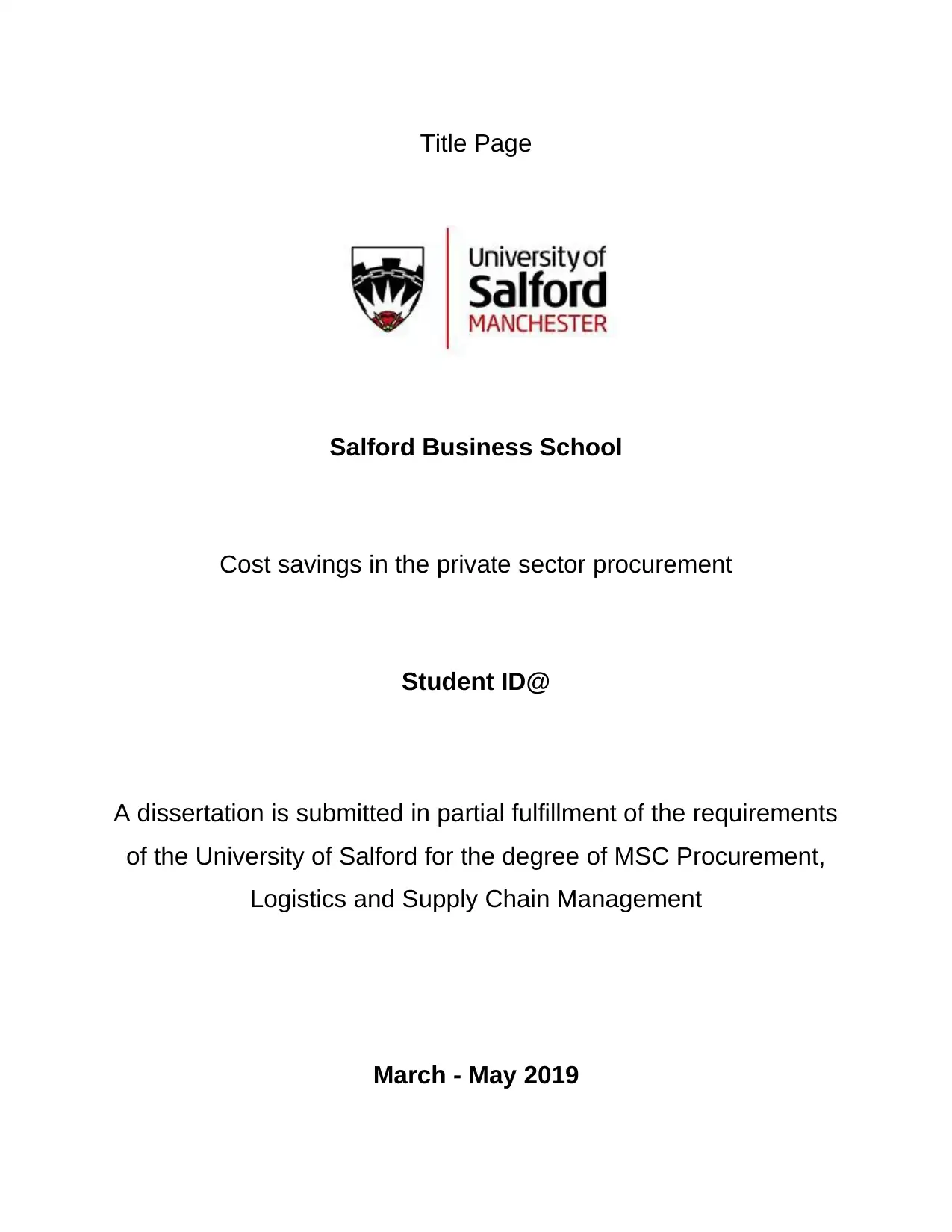
Title Page
Salford Business School
Cost savings in the private sector procurement
Student ID@
A dissertation is submitted in partial fulfillment of the requirements
of the University of Salford for the degree of MSC Procurement,
Logistics and Supply Chain Management
March - May 2019
Salford Business School
Cost savings in the private sector procurement
Student ID@
A dissertation is submitted in partial fulfillment of the requirements
of the University of Salford for the degree of MSC Procurement,
Logistics and Supply Chain Management
March - May 2019
Paraphrase This Document
Need a fresh take? Get an instant paraphrase of this document with our AI Paraphraser
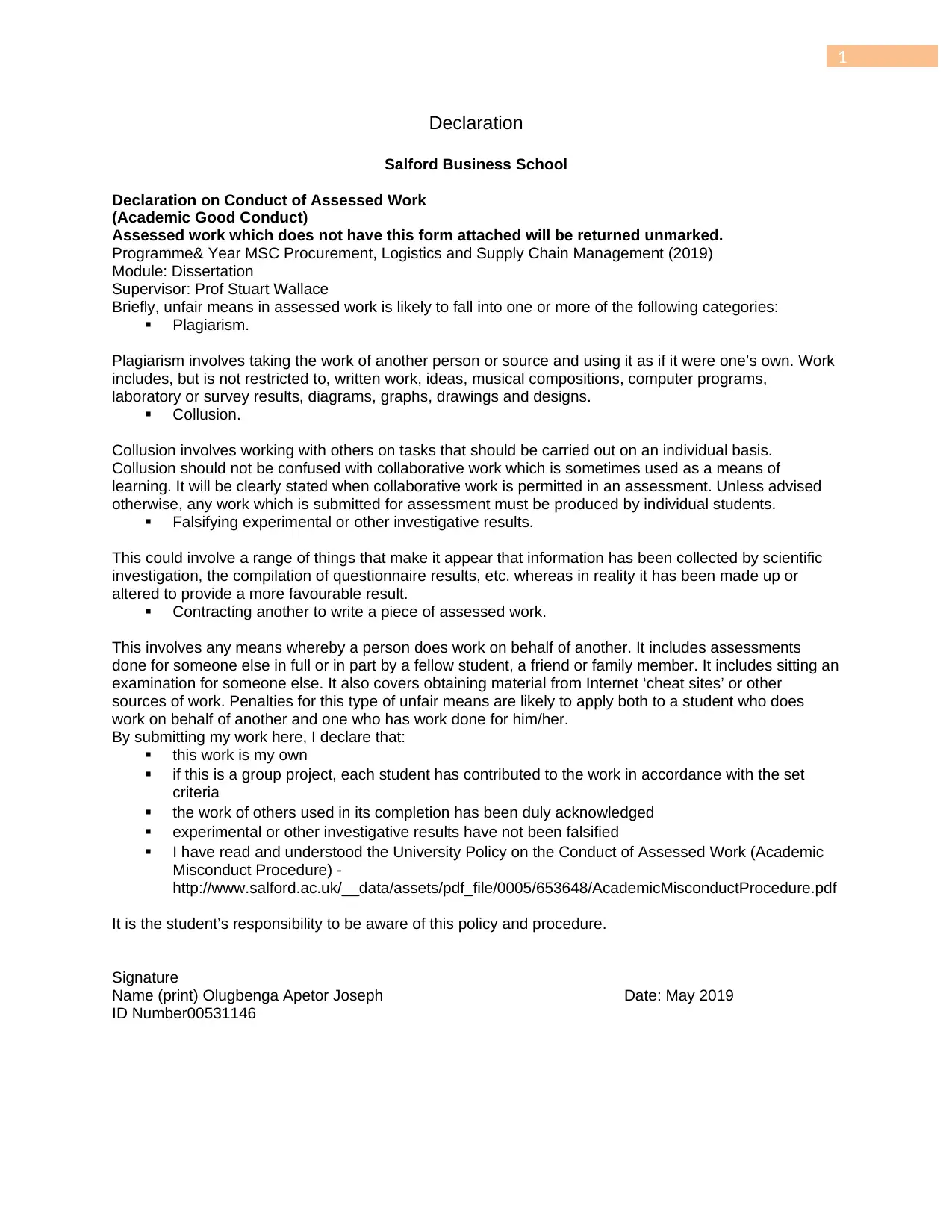
1
Declaration
Salford Business School
Declaration on Conduct of Assessed Work
(Academic Good Conduct)
Assessed work which does not have this form attached will be returned unmarked.
Programme& Year MSC Procurement, Logistics and Supply Chain Management (2019)
Module: Dissertation
Supervisor: Prof Stuart Wallace
Briefly, unfair means in assessed work is likely to fall into one or more of the following categories:
Plagiarism.
Plagiarism involves taking the work of another person or source and using it as if it were one’s own. Work
includes, but is not restricted to, written work, ideas, musical compositions, computer programs,
laboratory or survey results, diagrams, graphs, drawings and designs.
Collusion.
Collusion involves working with others on tasks that should be carried out on an individual basis.
Collusion should not be confused with collaborative work which is sometimes used as a means of
learning. It will be clearly stated when collaborative work is permitted in an assessment. Unless advised
otherwise, any work which is submitted for assessment must be produced by individual students.
Falsifying experimental or other investigative results.
This could involve a range of things that make it appear that information has been collected by scientific
investigation, the compilation of questionnaire results, etc. whereas in reality it has been made up or
altered to provide a more favourable result.
Contracting another to write a piece of assessed work.
This involves any means whereby a person does work on behalf of another. It includes assessments
done for someone else in full or in part by a fellow student, a friend or family member. It includes sitting an
examination for someone else. It also covers obtaining material from Internet ‘cheat sites’ or other
sources of work. Penalties for this type of unfair means are likely to apply both to a student who does
work on behalf of another and one who has work done for him/her.
By submitting my work here, I declare that:
this work is my own
if this is a group project, each student has contributed to the work in accordance with the set
criteria
the work of others used in its completion has been duly acknowledged
experimental or other investigative results have not been falsified
I have read and understood the University Policy on the Conduct of Assessed Work (Academic
Misconduct Procedure) -
http://www.salford.ac.uk/__data/assets/pdf_file/0005/653648/AcademicMisconductProcedure.pdf
It is the student’s responsibility to be aware of this policy and procedure.
Signature
Name (print) Olugbenga Apetor Joseph Date: May 2019
ID Number00531146
Declaration
Salford Business School
Declaration on Conduct of Assessed Work
(Academic Good Conduct)
Assessed work which does not have this form attached will be returned unmarked.
Programme& Year MSC Procurement, Logistics and Supply Chain Management (2019)
Module: Dissertation
Supervisor: Prof Stuart Wallace
Briefly, unfair means in assessed work is likely to fall into one or more of the following categories:
Plagiarism.
Plagiarism involves taking the work of another person or source and using it as if it were one’s own. Work
includes, but is not restricted to, written work, ideas, musical compositions, computer programs,
laboratory or survey results, diagrams, graphs, drawings and designs.
Collusion.
Collusion involves working with others on tasks that should be carried out on an individual basis.
Collusion should not be confused with collaborative work which is sometimes used as a means of
learning. It will be clearly stated when collaborative work is permitted in an assessment. Unless advised
otherwise, any work which is submitted for assessment must be produced by individual students.
Falsifying experimental or other investigative results.
This could involve a range of things that make it appear that information has been collected by scientific
investigation, the compilation of questionnaire results, etc. whereas in reality it has been made up or
altered to provide a more favourable result.
Contracting another to write a piece of assessed work.
This involves any means whereby a person does work on behalf of another. It includes assessments
done for someone else in full or in part by a fellow student, a friend or family member. It includes sitting an
examination for someone else. It also covers obtaining material from Internet ‘cheat sites’ or other
sources of work. Penalties for this type of unfair means are likely to apply both to a student who does
work on behalf of another and one who has work done for him/her.
By submitting my work here, I declare that:
this work is my own
if this is a group project, each student has contributed to the work in accordance with the set
criteria
the work of others used in its completion has been duly acknowledged
experimental or other investigative results have not been falsified
I have read and understood the University Policy on the Conduct of Assessed Work (Academic
Misconduct Procedure) -
http://www.salford.ac.uk/__data/assets/pdf_file/0005/653648/AcademicMisconductProcedure.pdf
It is the student’s responsibility to be aware of this policy and procedure.
Signature
Name (print) Olugbenga Apetor Joseph Date: May 2019
ID Number00531146
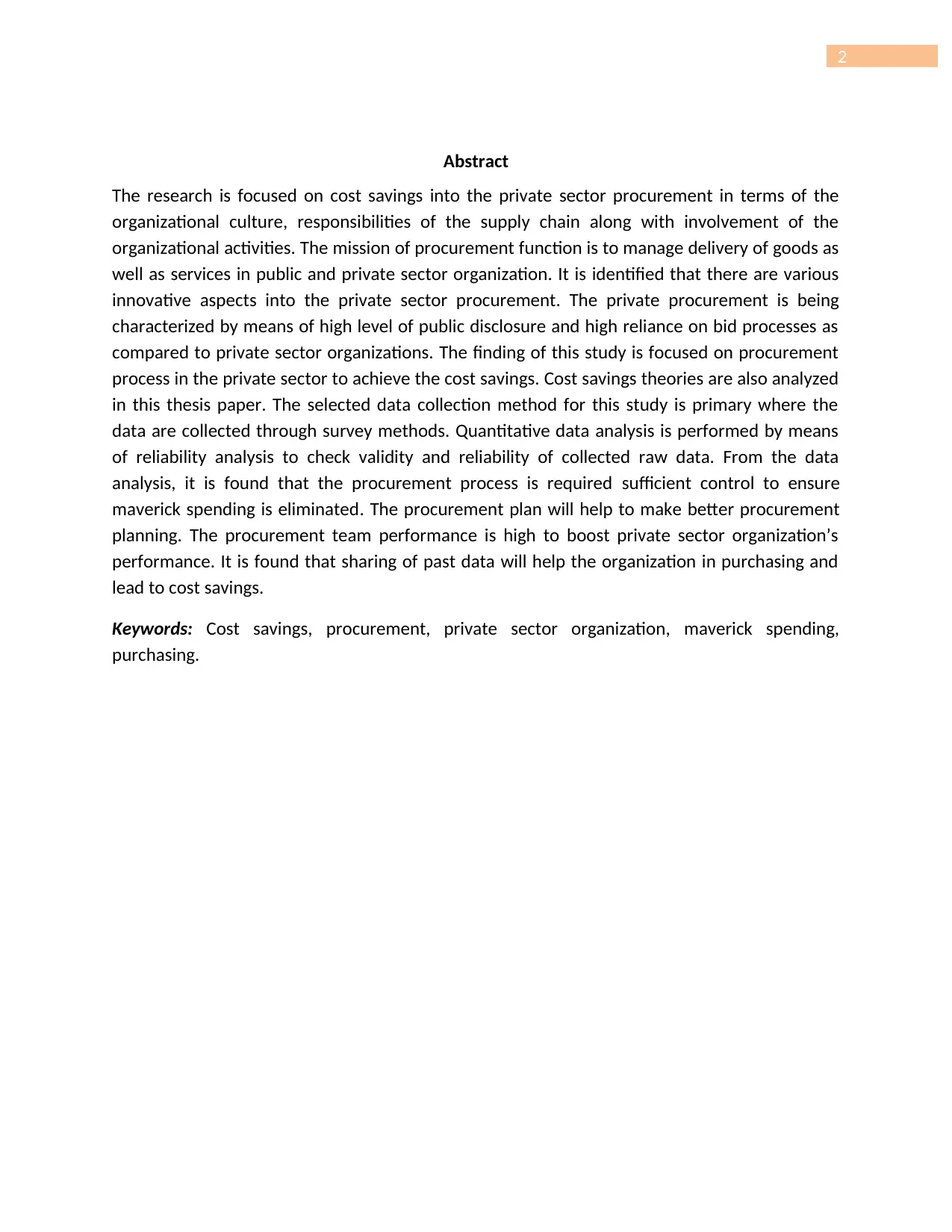
2
Abstract
The research is focused on cost savings into the private sector procurement in terms of the
organizational culture, responsibilities of the supply chain along with involvement of the
organizational activities. The mission of procurement function is to manage delivery of goods as
well as services in public and private sector organization. It is identified that there are various
innovative aspects into the private sector procurement. The private procurement is being
characterized by means of high level of public disclosure and high reliance on bid processes as
compared to private sector organizations. The finding of this study is focused on procurement
process in the private sector to achieve the cost savings. Cost savings theories are also analyzed
in this thesis paper. The selected data collection method for this study is primary where the
data are collected through survey methods. Quantitative data analysis is performed by means
of reliability analysis to check validity and reliability of collected raw data. From the data
analysis, it is found that the procurement process is required sufficient control to ensure
maverick spending is eliminated. The procurement plan will help to make better procurement
planning. The procurement team performance is high to boost private sector organization’s
performance. It is found that sharing of past data will help the organization in purchasing and
lead to cost savings.
Keywords: Cost savings, procurement, private sector organization, maverick spending,
purchasing.
Abstract
The research is focused on cost savings into the private sector procurement in terms of the
organizational culture, responsibilities of the supply chain along with involvement of the
organizational activities. The mission of procurement function is to manage delivery of goods as
well as services in public and private sector organization. It is identified that there are various
innovative aspects into the private sector procurement. The private procurement is being
characterized by means of high level of public disclosure and high reliance on bid processes as
compared to private sector organizations. The finding of this study is focused on procurement
process in the private sector to achieve the cost savings. Cost savings theories are also analyzed
in this thesis paper. The selected data collection method for this study is primary where the
data are collected through survey methods. Quantitative data analysis is performed by means
of reliability analysis to check validity and reliability of collected raw data. From the data
analysis, it is found that the procurement process is required sufficient control to ensure
maverick spending is eliminated. The procurement plan will help to make better procurement
planning. The procurement team performance is high to boost private sector organization’s
performance. It is found that sharing of past data will help the organization in purchasing and
lead to cost savings.
Keywords: Cost savings, procurement, private sector organization, maverick spending,
purchasing.
⊘ This is a preview!⊘
Do you want full access?
Subscribe today to unlock all pages.

Trusted by 1+ million students worldwide
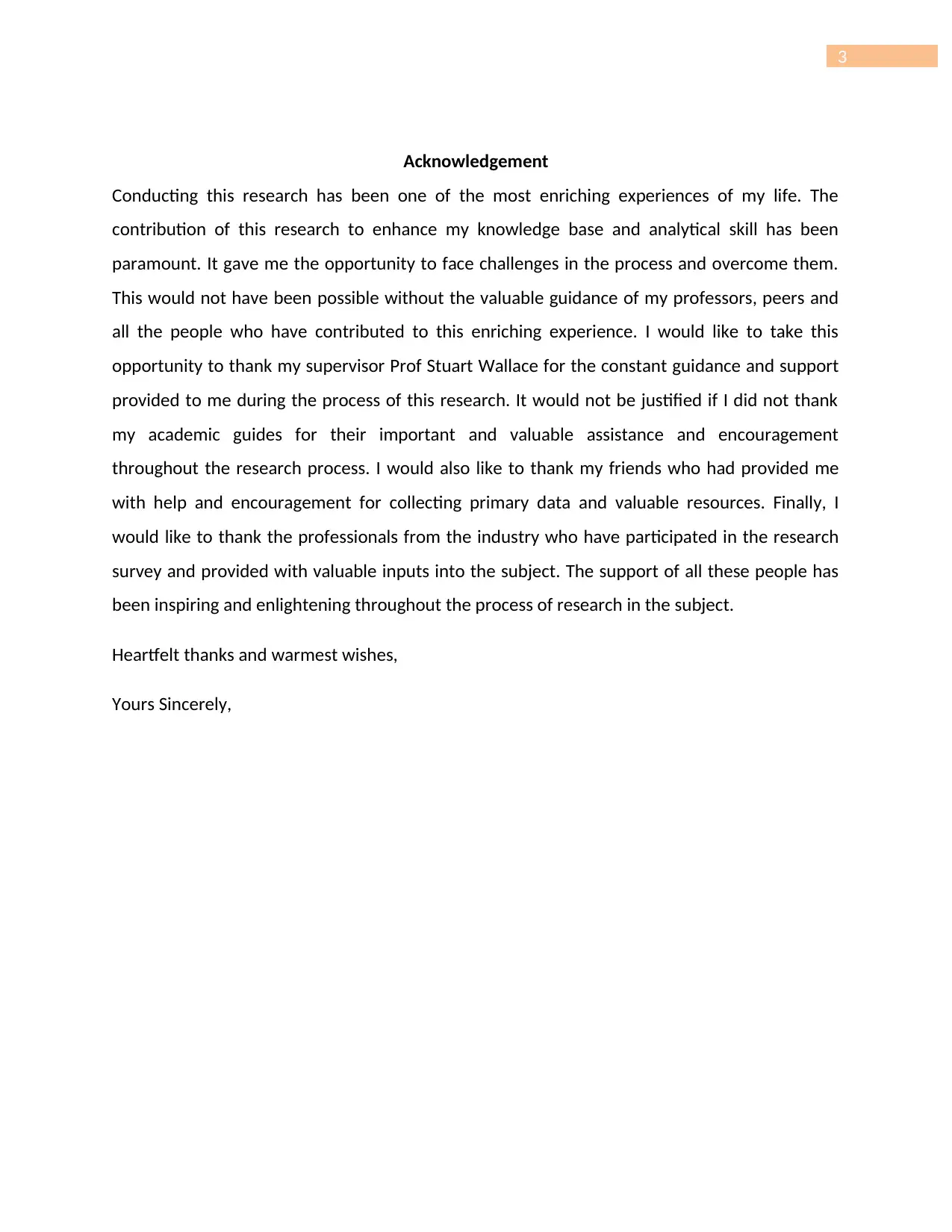
3
Acknowledgement
Conducting this research has been one of the most enriching experiences of my life. The
contribution of this research to enhance my knowledge base and analytical skill has been
paramount. It gave me the opportunity to face challenges in the process and overcome them.
This would not have been possible without the valuable guidance of my professors, peers and
all the people who have contributed to this enriching experience. I would like to take this
opportunity to thank my supervisor Prof Stuart Wallace for the constant guidance and support
provided to me during the process of this research. It would not be justified if I did not thank
my academic guides for their important and valuable assistance and encouragement
throughout the research process. I would also like to thank my friends who had provided me
with help and encouragement for collecting primary data and valuable resources. Finally, I
would like to thank the professionals from the industry who have participated in the research
survey and provided with valuable inputs into the subject. The support of all these people has
been inspiring and enlightening throughout the process of research in the subject.
Heartfelt thanks and warmest wishes,
Yours Sincerely,
Acknowledgement
Conducting this research has been one of the most enriching experiences of my life. The
contribution of this research to enhance my knowledge base and analytical skill has been
paramount. It gave me the opportunity to face challenges in the process and overcome them.
This would not have been possible without the valuable guidance of my professors, peers and
all the people who have contributed to this enriching experience. I would like to take this
opportunity to thank my supervisor Prof Stuart Wallace for the constant guidance and support
provided to me during the process of this research. It would not be justified if I did not thank
my academic guides for their important and valuable assistance and encouragement
throughout the research process. I would also like to thank my friends who had provided me
with help and encouragement for collecting primary data and valuable resources. Finally, I
would like to thank the professionals from the industry who have participated in the research
survey and provided with valuable inputs into the subject. The support of all these people has
been inspiring and enlightening throughout the process of research in the subject.
Heartfelt thanks and warmest wishes,
Yours Sincerely,
Paraphrase This Document
Need a fresh take? Get an instant paraphrase of this document with our AI Paraphraser
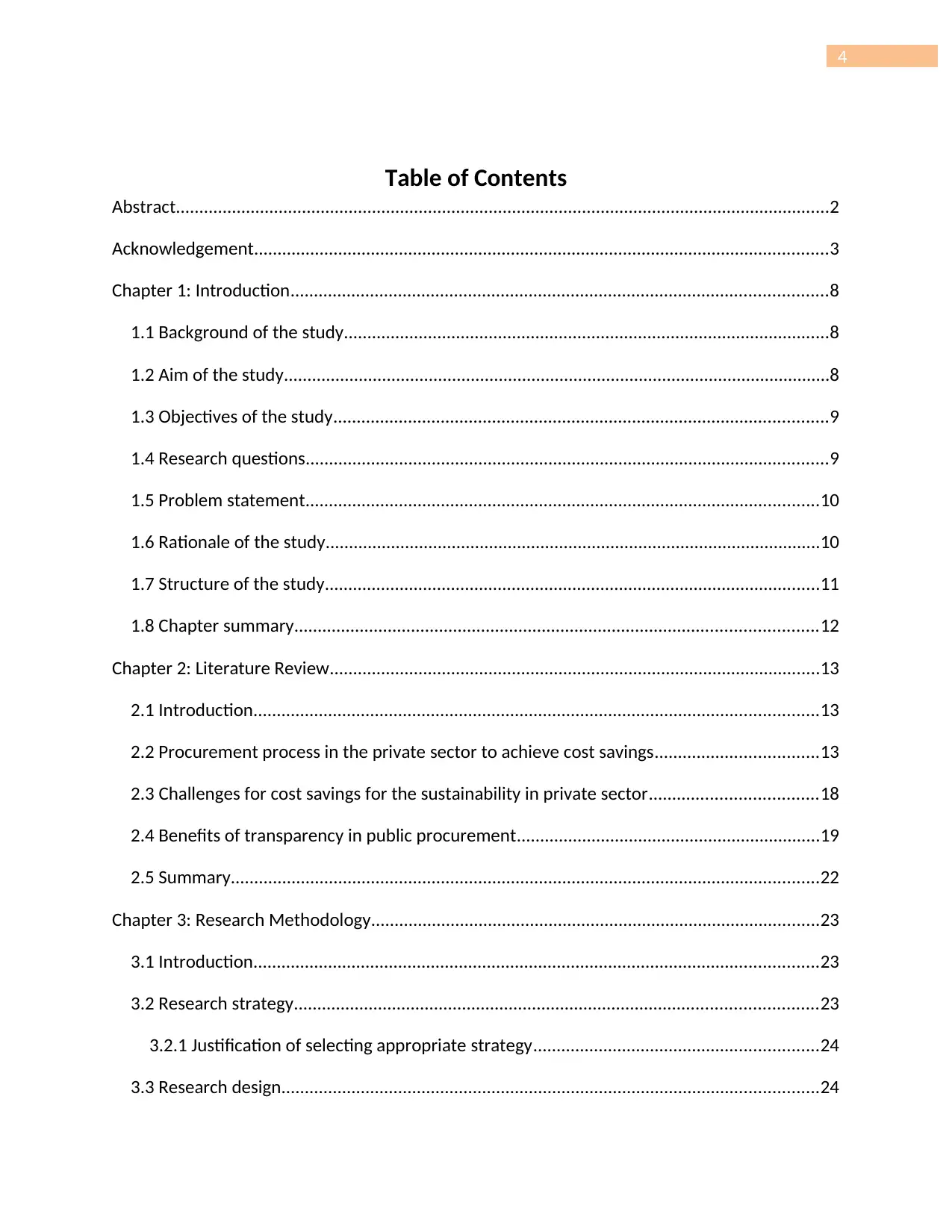
4
Table of Contents
Abstract............................................................................................................................................2
Acknowledgement...........................................................................................................................3
Chapter 1: Introduction...................................................................................................................8
1.1 Background of the study........................................................................................................8
1.2 Aim of the study.....................................................................................................................8
1.3 Objectives of the study..........................................................................................................9
1.4 Research questions................................................................................................................9
1.5 Problem statement..............................................................................................................10
1.6 Rationale of the study..........................................................................................................10
1.7 Structure of the study..........................................................................................................11
1.8 Chapter summary................................................................................................................12
Chapter 2: Literature Review.........................................................................................................13
2.1 Introduction.........................................................................................................................13
2.2 Procurement process in the private sector to achieve cost savings...................................13
2.3 Challenges for cost savings for the sustainability in private sector....................................18
2.4 Benefits of transparency in public procurement.................................................................19
2.5 Summary..............................................................................................................................22
Chapter 3: Research Methodology................................................................................................23
3.1 Introduction.........................................................................................................................23
3.2 Research strategy................................................................................................................23
3.2.1 Justification of selecting appropriate strategy.............................................................24
3.3 Research design...................................................................................................................24
Table of Contents
Abstract............................................................................................................................................2
Acknowledgement...........................................................................................................................3
Chapter 1: Introduction...................................................................................................................8
1.1 Background of the study........................................................................................................8
1.2 Aim of the study.....................................................................................................................8
1.3 Objectives of the study..........................................................................................................9
1.4 Research questions................................................................................................................9
1.5 Problem statement..............................................................................................................10
1.6 Rationale of the study..........................................................................................................10
1.7 Structure of the study..........................................................................................................11
1.8 Chapter summary................................................................................................................12
Chapter 2: Literature Review.........................................................................................................13
2.1 Introduction.........................................................................................................................13
2.2 Procurement process in the private sector to achieve cost savings...................................13
2.3 Challenges for cost savings for the sustainability in private sector....................................18
2.4 Benefits of transparency in public procurement.................................................................19
2.5 Summary..............................................................................................................................22
Chapter 3: Research Methodology................................................................................................23
3.1 Introduction.........................................................................................................................23
3.2 Research strategy................................................................................................................23
3.2.1 Justification of selecting appropriate strategy.............................................................24
3.3 Research design...................................................................................................................24
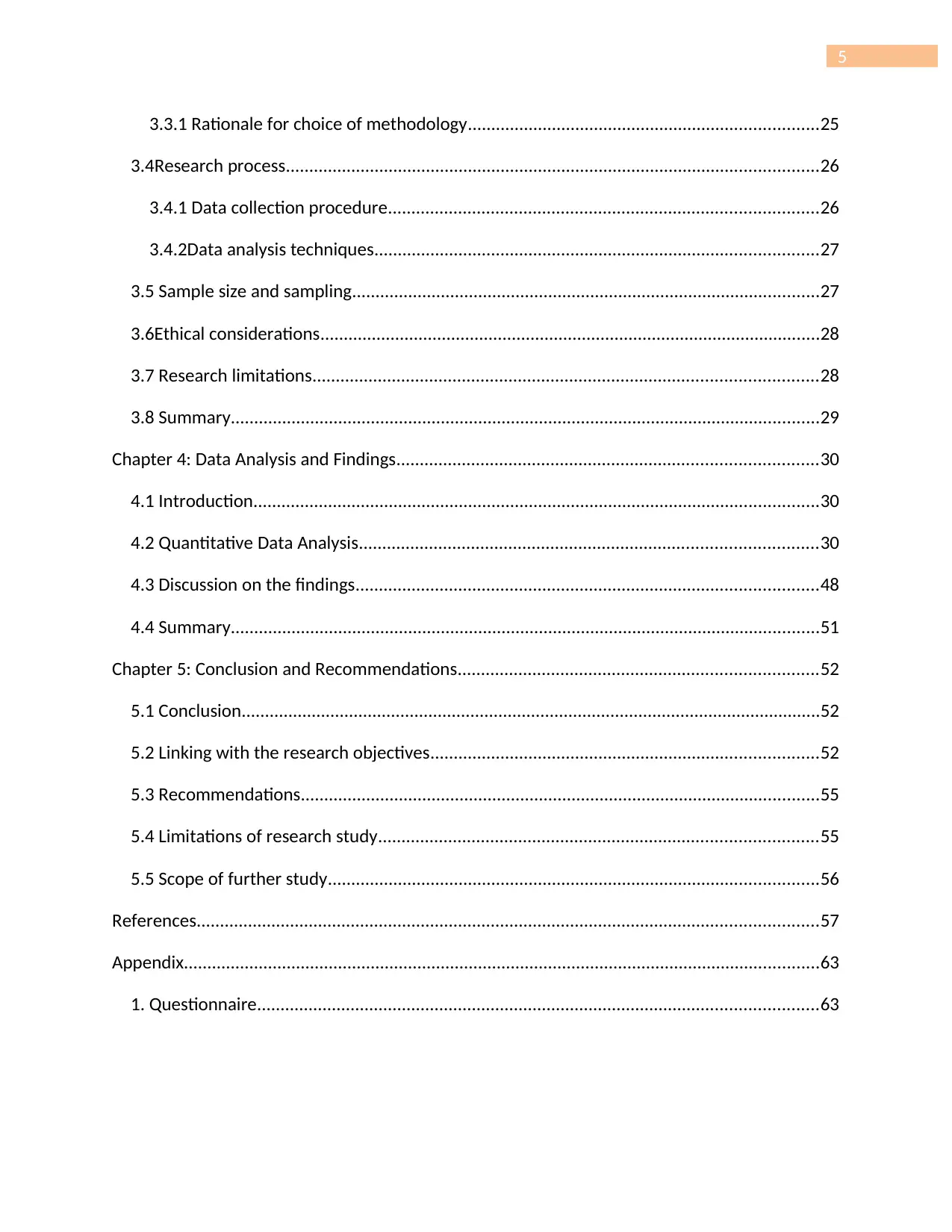
5
3.3.1 Rationale for choice of methodology...........................................................................25
3.4Research process..................................................................................................................26
3.4.1 Data collection procedure............................................................................................26
3.4.2Data analysis techniques...............................................................................................27
3.5 Sample size and sampling....................................................................................................27
3.6Ethical considerations...........................................................................................................28
3.7 Research limitations............................................................................................................28
3.8 Summary..............................................................................................................................29
Chapter 4: Data Analysis and Findings..........................................................................................30
4.1 Introduction.........................................................................................................................30
4.2 Quantitative Data Analysis..................................................................................................30
4.3 Discussion on the findings...................................................................................................48
4.4 Summary..............................................................................................................................51
Chapter 5: Conclusion and Recommendations.............................................................................52
5.1 Conclusion............................................................................................................................52
5.2 Linking with the research objectives...................................................................................52
5.3 Recommendations...............................................................................................................55
5.4 Limitations of research study..............................................................................................55
5.5 Scope of further study.........................................................................................................56
References.....................................................................................................................................57
Appendix........................................................................................................................................63
1. Questionnaire........................................................................................................................63
3.3.1 Rationale for choice of methodology...........................................................................25
3.4Research process..................................................................................................................26
3.4.1 Data collection procedure............................................................................................26
3.4.2Data analysis techniques...............................................................................................27
3.5 Sample size and sampling....................................................................................................27
3.6Ethical considerations...........................................................................................................28
3.7 Research limitations............................................................................................................28
3.8 Summary..............................................................................................................................29
Chapter 4: Data Analysis and Findings..........................................................................................30
4.1 Introduction.........................................................................................................................30
4.2 Quantitative Data Analysis..................................................................................................30
4.3 Discussion on the findings...................................................................................................48
4.4 Summary..............................................................................................................................51
Chapter 5: Conclusion and Recommendations.............................................................................52
5.1 Conclusion............................................................................................................................52
5.2 Linking with the research objectives...................................................................................52
5.3 Recommendations...............................................................................................................55
5.4 Limitations of research study..............................................................................................55
5.5 Scope of further study.........................................................................................................56
References.....................................................................................................................................57
Appendix........................................................................................................................................63
1. Questionnaire........................................................................................................................63
⊘ This is a preview!⊘
Do you want full access?
Subscribe today to unlock all pages.

Trusted by 1+ million students worldwide
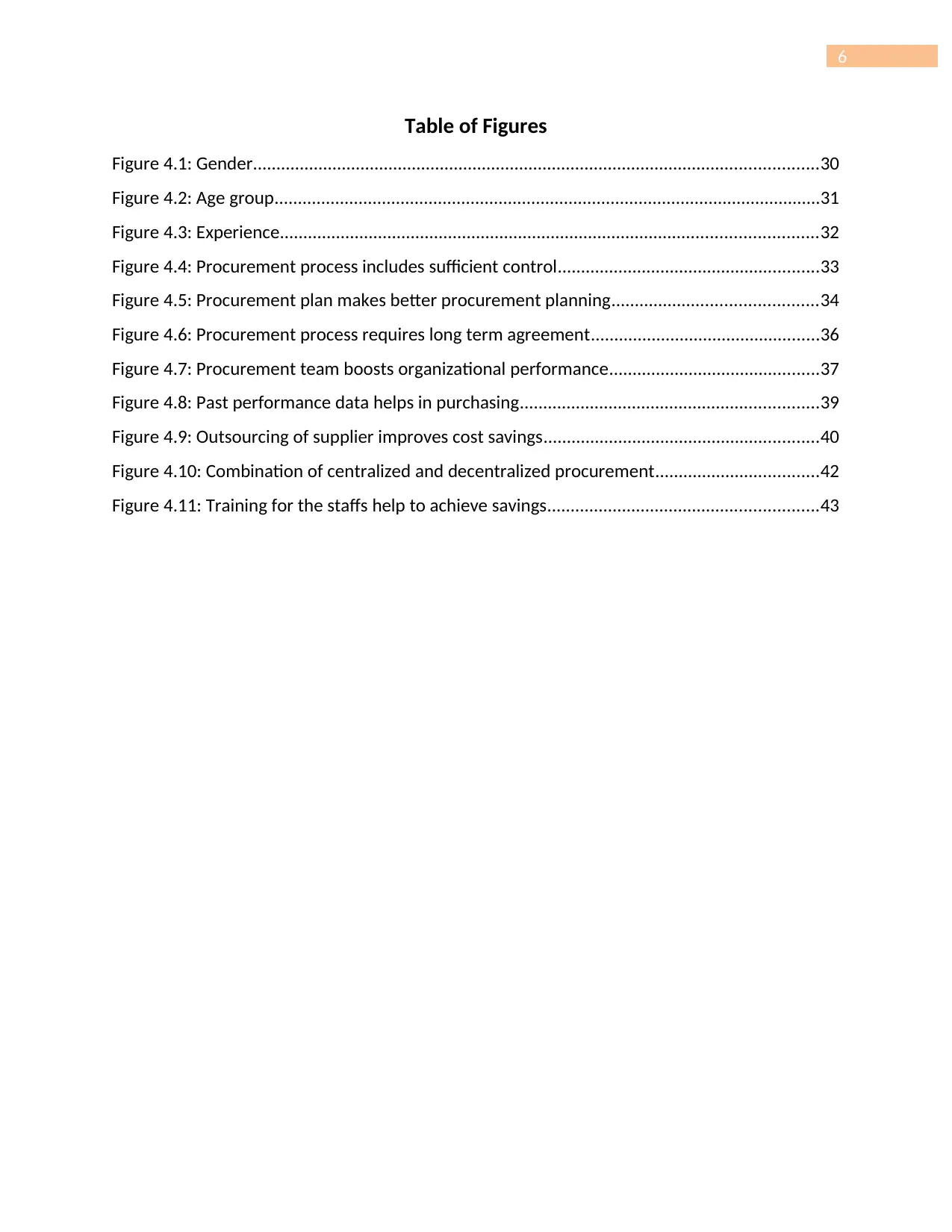
6
Table of Figures
Figure 4.1: Gender.........................................................................................................................30
Figure 4.2: Age group.....................................................................................................................31
Figure 4.3: Experience...................................................................................................................32
Figure 4.4: Procurement process includes sufficient control........................................................33
Figure 4.5: Procurement plan makes better procurement planning............................................34
Figure 4.6: Procurement process requires long term agreement.................................................36
Figure 4.7: Procurement team boosts organizational performance.............................................37
Figure 4.8: Past performance data helps in purchasing................................................................39
Figure 4.9: Outsourcing of supplier improves cost savings...........................................................40
Figure 4.10: Combination of centralized and decentralized procurement...................................42
Figure 4.11: Training for the staffs help to achieve savings..........................................................43
Table of Figures
Figure 4.1: Gender.........................................................................................................................30
Figure 4.2: Age group.....................................................................................................................31
Figure 4.3: Experience...................................................................................................................32
Figure 4.4: Procurement process includes sufficient control........................................................33
Figure 4.5: Procurement plan makes better procurement planning............................................34
Figure 4.6: Procurement process requires long term agreement.................................................36
Figure 4.7: Procurement team boosts organizational performance.............................................37
Figure 4.8: Past performance data helps in purchasing................................................................39
Figure 4.9: Outsourcing of supplier improves cost savings...........................................................40
Figure 4.10: Combination of centralized and decentralized procurement...................................42
Figure 4.11: Training for the staffs help to achieve savings..........................................................43
Paraphrase This Document
Need a fresh take? Get an instant paraphrase of this document with our AI Paraphraser
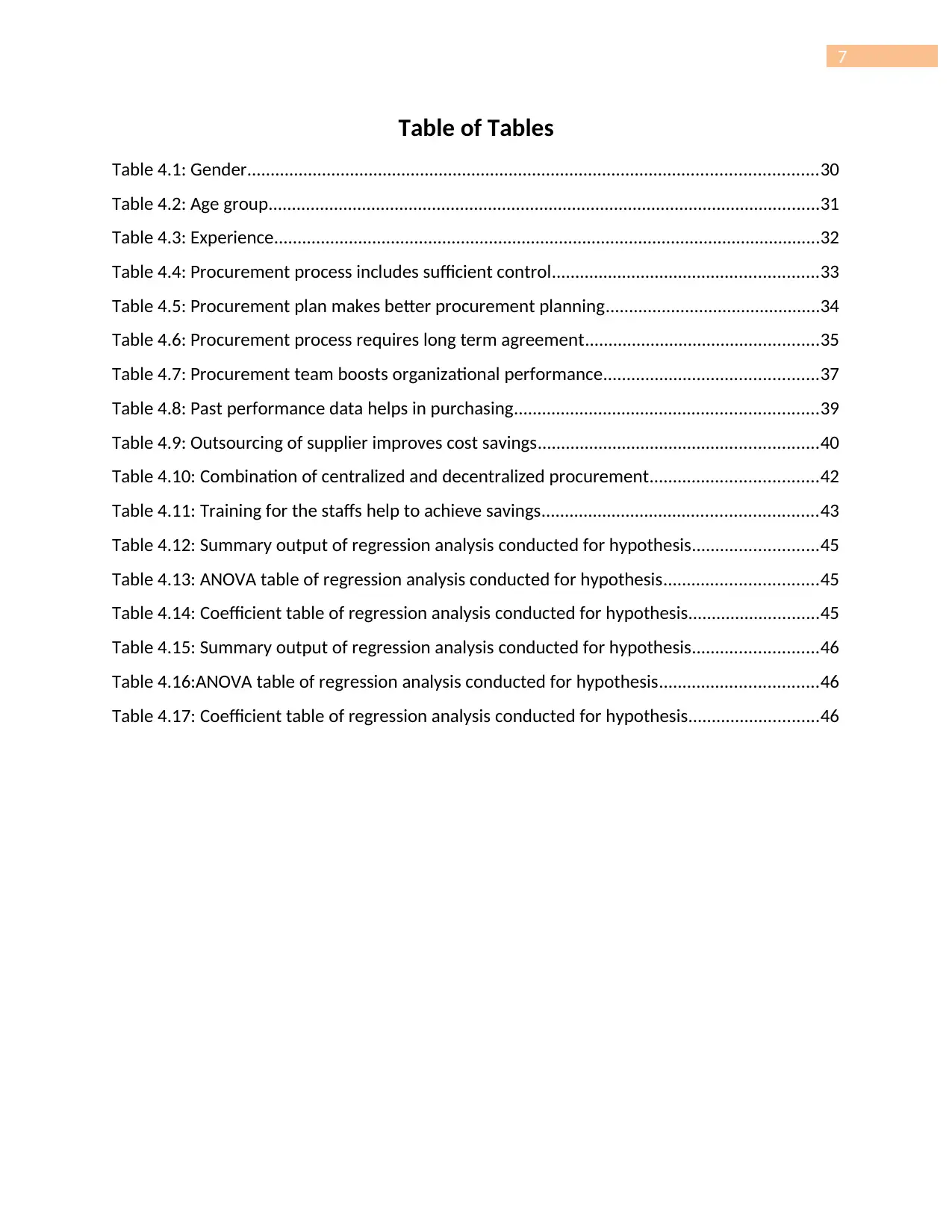
7
Table of Tables
Table 4.1: Gender..........................................................................................................................30
Table 4.2: Age group......................................................................................................................31
Table 4.3: Experience.....................................................................................................................32
Table 4.4: Procurement process includes sufficient control.........................................................33
Table 4.5: Procurement plan makes better procurement planning..............................................34
Table 4.6: Procurement process requires long term agreement..................................................35
Table 4.7: Procurement team boosts organizational performance..............................................37
Table 4.8: Past performance data helps in purchasing.................................................................39
Table 4.9: Outsourcing of supplier improves cost savings............................................................40
Table 4.10: Combination of centralized and decentralized procurement....................................42
Table 4.11: Training for the staffs help to achieve savings...........................................................43
Table 4.12: Summary output of regression analysis conducted for hypothesis...........................45
Table 4.13: ANOVA table of regression analysis conducted for hypothesis.................................45
Table 4.14: Coefficient table of regression analysis conducted for hypothesis............................45
Table 4.15: Summary output of regression analysis conducted for hypothesis...........................46
Table 4.16:ANOVA table of regression analysis conducted for hypothesis..................................46
Table 4.17: Coefficient table of regression analysis conducted for hypothesis............................46
Table of Tables
Table 4.1: Gender..........................................................................................................................30
Table 4.2: Age group......................................................................................................................31
Table 4.3: Experience.....................................................................................................................32
Table 4.4: Procurement process includes sufficient control.........................................................33
Table 4.5: Procurement plan makes better procurement planning..............................................34
Table 4.6: Procurement process requires long term agreement..................................................35
Table 4.7: Procurement team boosts organizational performance..............................................37
Table 4.8: Past performance data helps in purchasing.................................................................39
Table 4.9: Outsourcing of supplier improves cost savings............................................................40
Table 4.10: Combination of centralized and decentralized procurement....................................42
Table 4.11: Training for the staffs help to achieve savings...........................................................43
Table 4.12: Summary output of regression analysis conducted for hypothesis...........................45
Table 4.13: ANOVA table of regression analysis conducted for hypothesis.................................45
Table 4.14: Coefficient table of regression analysis conducted for hypothesis............................45
Table 4.15: Summary output of regression analysis conducted for hypothesis...........................46
Table 4.16:ANOVA table of regression analysis conducted for hypothesis..................................46
Table 4.17: Coefficient table of regression analysis conducted for hypothesis............................46
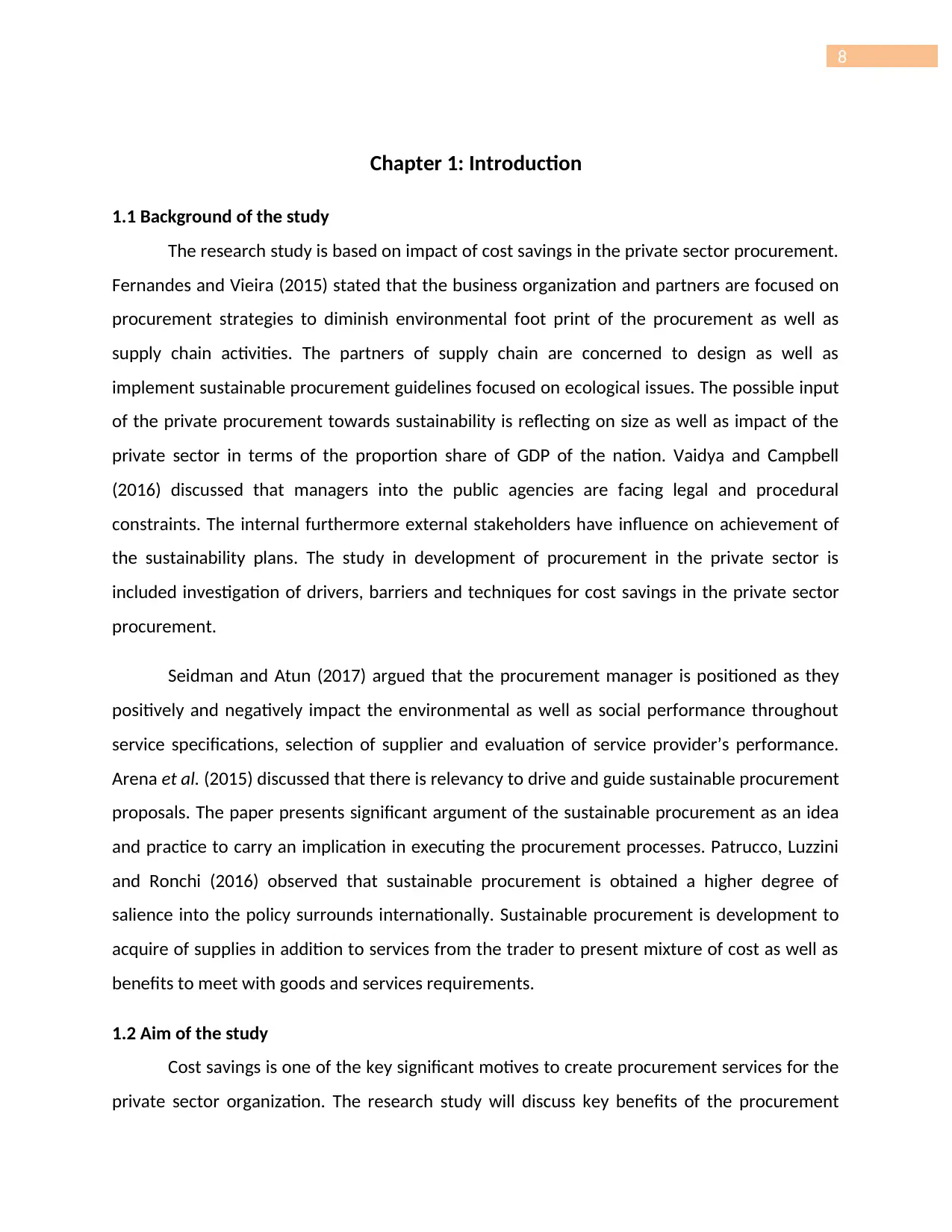
8
Chapter 1: Introduction
1.1 Background of the study
The research study is based on impact of cost savings in the private sector procurement.
Fernandes and Vieira (2015) stated that the business organization and partners are focused on
procurement strategies to diminish environmental foot print of the procurement as well as
supply chain activities. The partners of supply chain are concerned to design as well as
implement sustainable procurement guidelines focused on ecological issues. The possible input
of the private procurement towards sustainability is reflecting on size as well as impact of the
private sector in terms of the proportion share of GDP of the nation. Vaidya and Campbell
(2016) discussed that managers into the public agencies are facing legal and procedural
constraints. The internal furthermore external stakeholders have influence on achievement of
the sustainability plans. The study in development of procurement in the private sector is
included investigation of drivers, barriers and techniques for cost savings in the private sector
procurement.
Seidman and Atun (2017) argued that the procurement manager is positioned as they
positively and negatively impact the environmental as well as social performance throughout
service specifications, selection of supplier and evaluation of service provider’s performance.
Arena et al. (2015) discussed that there is relevancy to drive and guide sustainable procurement
proposals. The paper presents significant argument of the sustainable procurement as an idea
and practice to carry an implication in executing the procurement processes. Patrucco, Luzzini
and Ronchi (2016) observed that sustainable procurement is obtained a higher degree of
salience into the policy surrounds internationally. Sustainable procurement is development to
acquire of supplies in addition to services from the trader to present mixture of cost as well as
benefits to meet with goods and services requirements.
1.2 Aim of the study
Cost savings is one of the key significant motives to create procurement services for the
private sector organization. The research study will discuss key benefits of the procurement
Chapter 1: Introduction
1.1 Background of the study
The research study is based on impact of cost savings in the private sector procurement.
Fernandes and Vieira (2015) stated that the business organization and partners are focused on
procurement strategies to diminish environmental foot print of the procurement as well as
supply chain activities. The partners of supply chain are concerned to design as well as
implement sustainable procurement guidelines focused on ecological issues. The possible input
of the private procurement towards sustainability is reflecting on size as well as impact of the
private sector in terms of the proportion share of GDP of the nation. Vaidya and Campbell
(2016) discussed that managers into the public agencies are facing legal and procedural
constraints. The internal furthermore external stakeholders have influence on achievement of
the sustainability plans. The study in development of procurement in the private sector is
included investigation of drivers, barriers and techniques for cost savings in the private sector
procurement.
Seidman and Atun (2017) argued that the procurement manager is positioned as they
positively and negatively impact the environmental as well as social performance throughout
service specifications, selection of supplier and evaluation of service provider’s performance.
Arena et al. (2015) discussed that there is relevancy to drive and guide sustainable procurement
proposals. The paper presents significant argument of the sustainable procurement as an idea
and practice to carry an implication in executing the procurement processes. Patrucco, Luzzini
and Ronchi (2016) observed that sustainable procurement is obtained a higher degree of
salience into the policy surrounds internationally. Sustainable procurement is development to
acquire of supplies in addition to services from the trader to present mixture of cost as well as
benefits to meet with goods and services requirements.
1.2 Aim of the study
Cost savings is one of the key significant motives to create procurement services for the
private sector organization. The research study will discuss key benefits of the procurement
⊘ This is a preview!⊘
Do you want full access?
Subscribe today to unlock all pages.

Trusted by 1+ million students worldwide
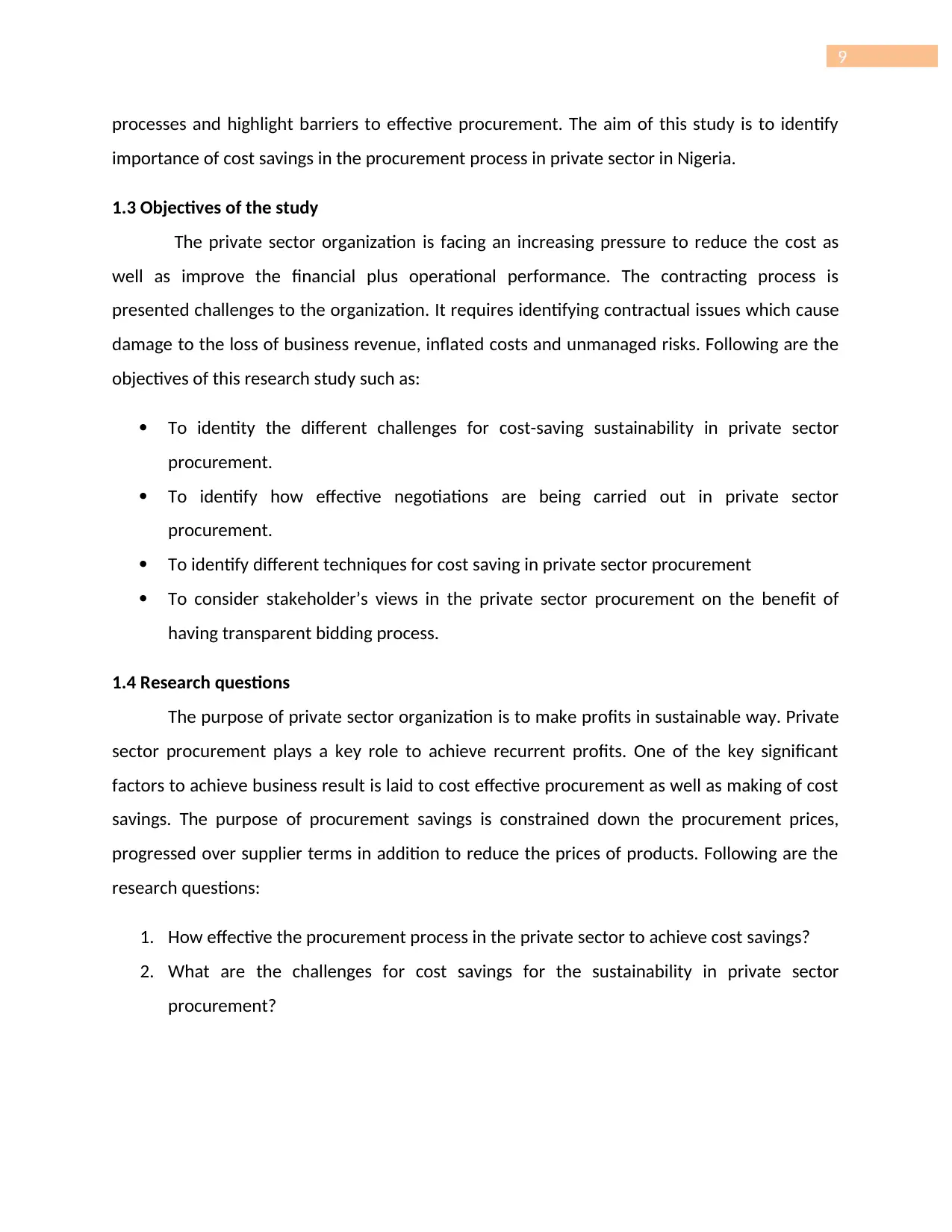
9
processes and highlight barriers to effective procurement. The aim of this study is to identify
importance of cost savings in the procurement process in private sector in Nigeria.
1.3 Objectives of the study
The private sector organization is facing an increasing pressure to reduce the cost as
well as improve the financial plus operational performance. The contracting process is
presented challenges to the organization. It requires identifying contractual issues which cause
damage to the loss of business revenue, inflated costs and unmanaged risks. Following are the
objectives of this research study such as:
To identity the different challenges for cost-saving sustainability in private sector
procurement.
To identify how effective negotiations are being carried out in private sector
procurement.
To identify different techniques for cost saving in private sector procurement
To consider stakeholder’s views in the private sector procurement on the benefit of
having transparent bidding process.
1.4 Research questions
The purpose of private sector organization is to make profits in sustainable way. Private
sector procurement plays a key role to achieve recurrent profits. One of the key significant
factors to achieve business result is laid to cost effective procurement as well as making of cost
savings. The purpose of procurement savings is constrained down the procurement prices,
progressed over supplier terms in addition to reduce the prices of products. Following are the
research questions:
1. How effective the procurement process in the private sector to achieve cost savings?
2. What are the challenges for cost savings for the sustainability in private sector
procurement?
processes and highlight barriers to effective procurement. The aim of this study is to identify
importance of cost savings in the procurement process in private sector in Nigeria.
1.3 Objectives of the study
The private sector organization is facing an increasing pressure to reduce the cost as
well as improve the financial plus operational performance. The contracting process is
presented challenges to the organization. It requires identifying contractual issues which cause
damage to the loss of business revenue, inflated costs and unmanaged risks. Following are the
objectives of this research study such as:
To identity the different challenges for cost-saving sustainability in private sector
procurement.
To identify how effective negotiations are being carried out in private sector
procurement.
To identify different techniques for cost saving in private sector procurement
To consider stakeholder’s views in the private sector procurement on the benefit of
having transparent bidding process.
1.4 Research questions
The purpose of private sector organization is to make profits in sustainable way. Private
sector procurement plays a key role to achieve recurrent profits. One of the key significant
factors to achieve business result is laid to cost effective procurement as well as making of cost
savings. The purpose of procurement savings is constrained down the procurement prices,
progressed over supplier terms in addition to reduce the prices of products. Following are the
research questions:
1. How effective the procurement process in the private sector to achieve cost savings?
2. What are the challenges for cost savings for the sustainability in private sector
procurement?
Paraphrase This Document
Need a fresh take? Get an instant paraphrase of this document with our AI Paraphraser
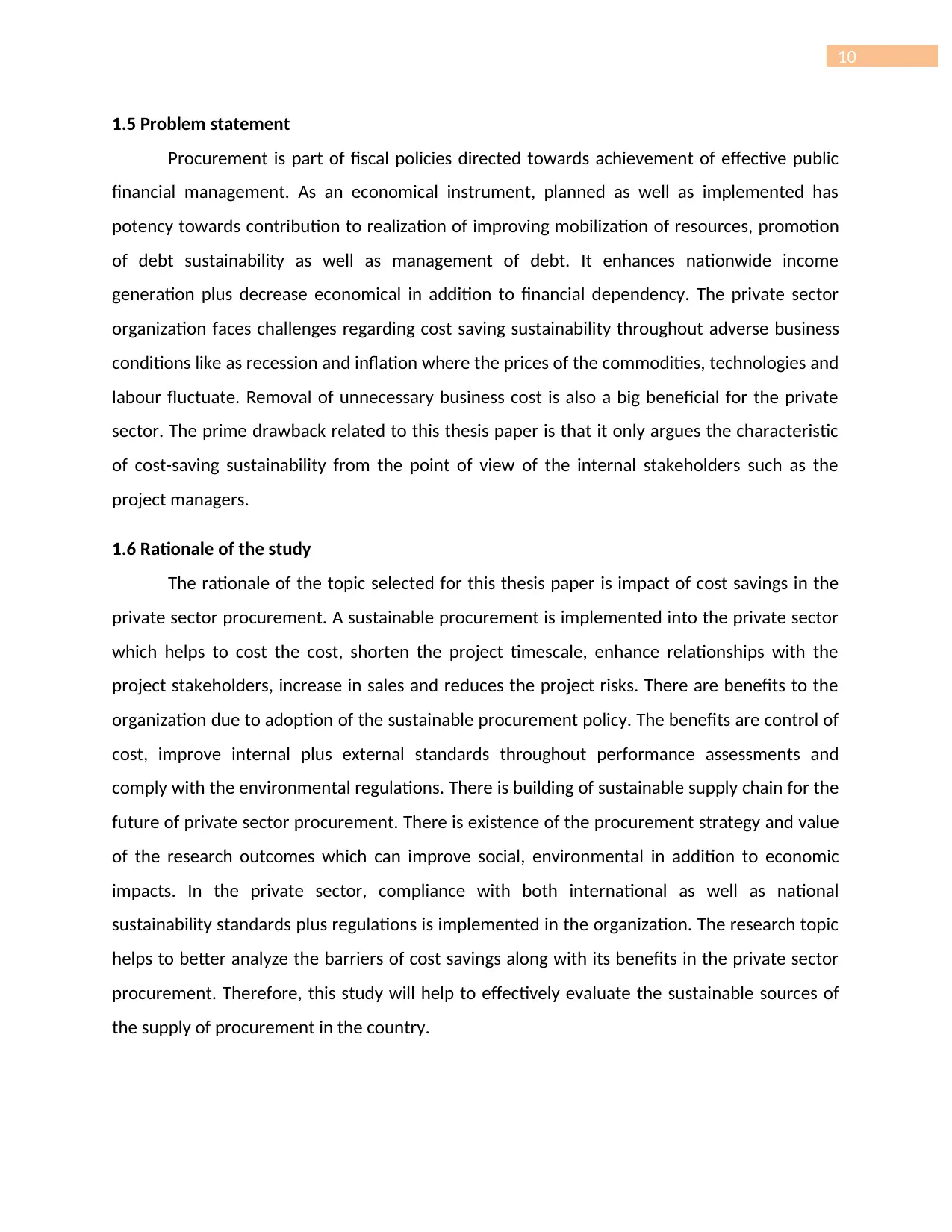
10
1.5 Problem statement
Procurement is part of fiscal policies directed towards achievement of effective public
financial management. As an economical instrument, planned as well as implemented has
potency towards contribution to realization of improving mobilization of resources, promotion
of debt sustainability as well as management of debt. It enhances nationwide income
generation plus decrease economical in addition to financial dependency. The private sector
organization faces challenges regarding cost saving sustainability throughout adverse business
conditions like as recession and inflation where the prices of the commodities, technologies and
labour fluctuate. Removal of unnecessary business cost is also a big beneficial for the private
sector. The prime drawback related to this thesis paper is that it only argues the characteristic
of cost-saving sustainability from the point of view of the internal stakeholders such as the
project managers.
1.6 Rationale of the study
The rationale of the topic selected for this thesis paper is impact of cost savings in the
private sector procurement. A sustainable procurement is implemented into the private sector
which helps to cost the cost, shorten the project timescale, enhance relationships with the
project stakeholders, increase in sales and reduces the project risks. There are benefits to the
organization due to adoption of the sustainable procurement policy. The benefits are control of
cost, improve internal plus external standards throughout performance assessments and
comply with the environmental regulations. There is building of sustainable supply chain for the
future of private sector procurement. There is existence of the procurement strategy and value
of the research outcomes which can improve social, environmental in addition to economic
impacts. In the private sector, compliance with both international as well as national
sustainability standards plus regulations is implemented in the organization. The research topic
helps to better analyze the barriers of cost savings along with its benefits in the private sector
procurement. Therefore, this study will help to effectively evaluate the sustainable sources of
the supply of procurement in the country.
1.5 Problem statement
Procurement is part of fiscal policies directed towards achievement of effective public
financial management. As an economical instrument, planned as well as implemented has
potency towards contribution to realization of improving mobilization of resources, promotion
of debt sustainability as well as management of debt. It enhances nationwide income
generation plus decrease economical in addition to financial dependency. The private sector
organization faces challenges regarding cost saving sustainability throughout adverse business
conditions like as recession and inflation where the prices of the commodities, technologies and
labour fluctuate. Removal of unnecessary business cost is also a big beneficial for the private
sector. The prime drawback related to this thesis paper is that it only argues the characteristic
of cost-saving sustainability from the point of view of the internal stakeholders such as the
project managers.
1.6 Rationale of the study
The rationale of the topic selected for this thesis paper is impact of cost savings in the
private sector procurement. A sustainable procurement is implemented into the private sector
which helps to cost the cost, shorten the project timescale, enhance relationships with the
project stakeholders, increase in sales and reduces the project risks. There are benefits to the
organization due to adoption of the sustainable procurement policy. The benefits are control of
cost, improve internal plus external standards throughout performance assessments and
comply with the environmental regulations. There is building of sustainable supply chain for the
future of private sector procurement. There is existence of the procurement strategy and value
of the research outcomes which can improve social, environmental in addition to economic
impacts. In the private sector, compliance with both international as well as national
sustainability standards plus regulations is implemented in the organization. The research topic
helps to better analyze the barriers of cost savings along with its benefits in the private sector
procurement. Therefore, this study will help to effectively evaluate the sustainable sources of
the supply of procurement in the country.
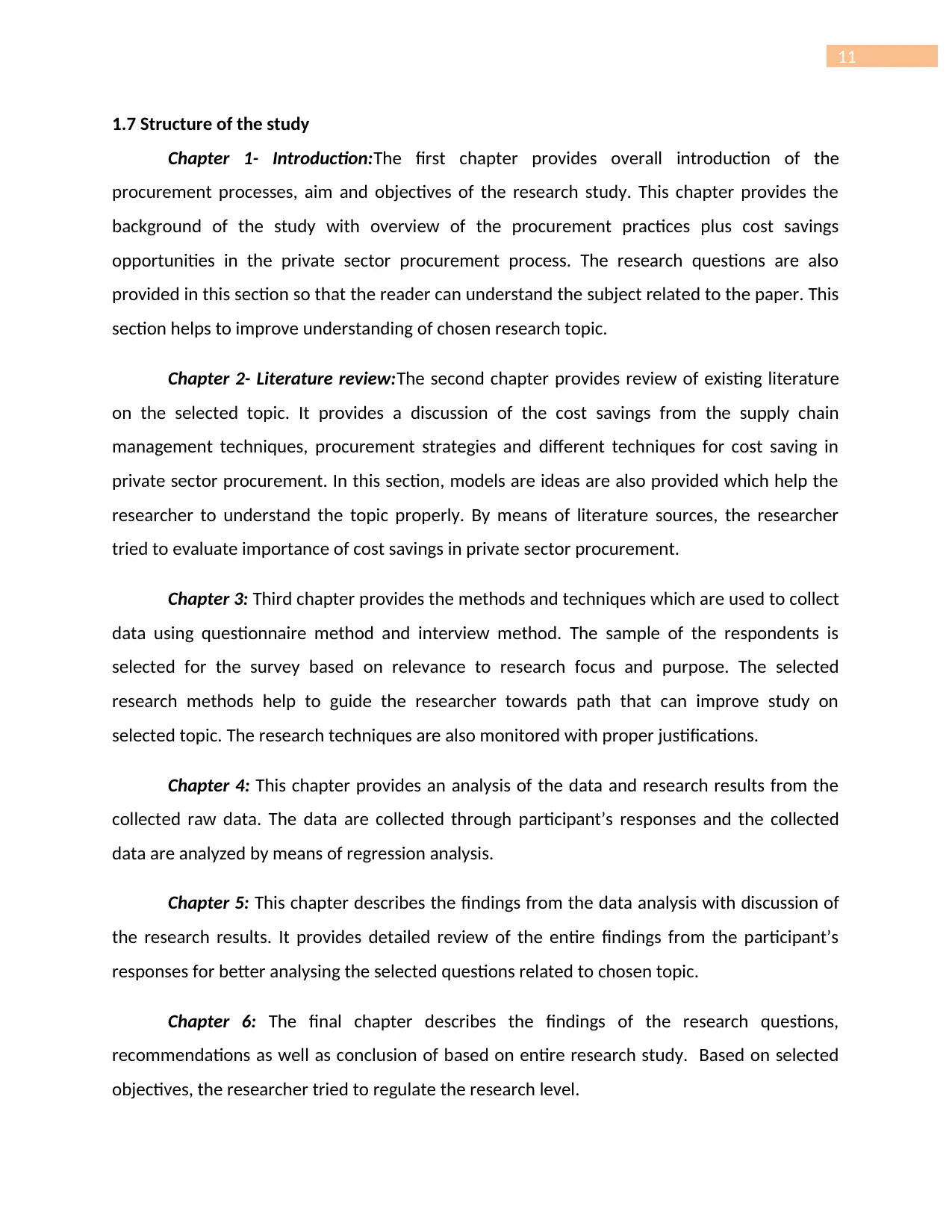
11
1.7 Structure of the study
Chapter 1- Introduction:The first chapter provides overall introduction of the
procurement processes, aim and objectives of the research study. This chapter provides the
background of the study with overview of the procurement practices plus cost savings
opportunities in the private sector procurement process. The research questions are also
provided in this section so that the reader can understand the subject related to the paper. This
section helps to improve understanding of chosen research topic.
Chapter 2- Literature review:The second chapter provides review of existing literature
on the selected topic. It provides a discussion of the cost savings from the supply chain
management techniques, procurement strategies and different techniques for cost saving in
private sector procurement. In this section, models are ideas are also provided which help the
researcher to understand the topic properly. By means of literature sources, the researcher
tried to evaluate importance of cost savings in private sector procurement.
Chapter 3: Third chapter provides the methods and techniques which are used to collect
data using questionnaire method and interview method. The sample of the respondents is
selected for the survey based on relevance to research focus and purpose. The selected
research methods help to guide the researcher towards path that can improve study on
selected topic. The research techniques are also monitored with proper justifications.
Chapter 4: This chapter provides an analysis of the data and research results from the
collected raw data. The data are collected through participant’s responses and the collected
data are analyzed by means of regression analysis.
Chapter 5: This chapter describes the findings from the data analysis with discussion of
the research results. It provides detailed review of the entire findings from the participant’s
responses for better analysing the selected questions related to chosen topic.
Chapter 6: The final chapter describes the findings of the research questions,
recommendations as well as conclusion of based on entire research study. Based on selected
objectives, the researcher tried to regulate the research level.
1.7 Structure of the study
Chapter 1- Introduction:The first chapter provides overall introduction of the
procurement processes, aim and objectives of the research study. This chapter provides the
background of the study with overview of the procurement practices plus cost savings
opportunities in the private sector procurement process. The research questions are also
provided in this section so that the reader can understand the subject related to the paper. This
section helps to improve understanding of chosen research topic.
Chapter 2- Literature review:The second chapter provides review of existing literature
on the selected topic. It provides a discussion of the cost savings from the supply chain
management techniques, procurement strategies and different techniques for cost saving in
private sector procurement. In this section, models are ideas are also provided which help the
researcher to understand the topic properly. By means of literature sources, the researcher
tried to evaluate importance of cost savings in private sector procurement.
Chapter 3: Third chapter provides the methods and techniques which are used to collect
data using questionnaire method and interview method. The sample of the respondents is
selected for the survey based on relevance to research focus and purpose. The selected
research methods help to guide the researcher towards path that can improve study on
selected topic. The research techniques are also monitored with proper justifications.
Chapter 4: This chapter provides an analysis of the data and research results from the
collected raw data. The data are collected through participant’s responses and the collected
data are analyzed by means of regression analysis.
Chapter 5: This chapter describes the findings from the data analysis with discussion of
the research results. It provides detailed review of the entire findings from the participant’s
responses for better analysing the selected questions related to chosen topic.
Chapter 6: The final chapter describes the findings of the research questions,
recommendations as well as conclusion of based on entire research study. Based on selected
objectives, the researcher tried to regulate the research level.
⊘ This is a preview!⊘
Do you want full access?
Subscribe today to unlock all pages.

Trusted by 1+ million students worldwide
1 out of 67
Related Documents
Your All-in-One AI-Powered Toolkit for Academic Success.
+13062052269
info@desklib.com
Available 24*7 on WhatsApp / Email
![[object Object]](/_next/static/media/star-bottom.7253800d.svg)
Unlock your academic potential
Copyright © 2020–2025 A2Z Services. All Rights Reserved. Developed and managed by ZUCOL.



